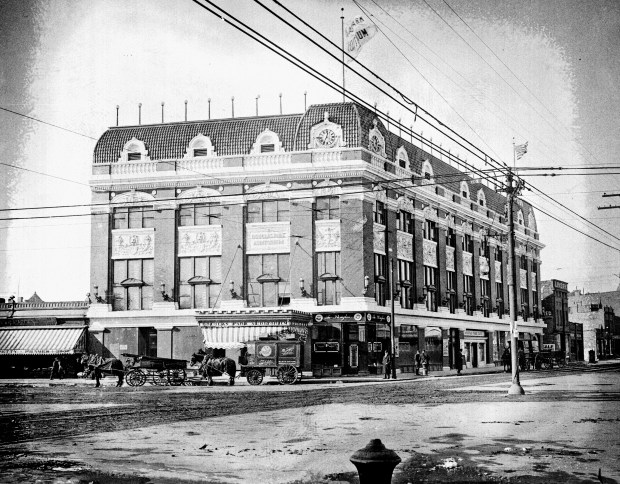If the walls of the Douglas Park Auditorium could talk, they might well speak Yiddish. A three-story structure, its facade sporting bas-relief lions and angels, it stands at the intersection of Kedzie and Ogden avenues. When it opened around 1911, Eastern European immigrants were transforming North Lawndale into a Jewish neighborhood.
Their ears were attuned to the overtly sweet and unabashedly sentimental cadences of the Douglas Park Auditorium’s Yiddish theatrical troupe. Maynard Wishner was child member of the troupe who went on to a distinguished legal career that included a stint as executive director of Chicago’s Commission on Human Rights.
“The Douglas Park Theatre did not aspire to great artistic theater,” Wishner recalled in a 2000 interview with the Chicago Reader. “This was a people’s theater.”
“They were all so alike,” he recalled, rattling off a series of typically schmaltzy plays: “‘A Mother’s Heart’, ‘A Mother’s Tears,’ ‘A Mother’s Heart and Tears.’ ”
The Yiddish theater was just one of many activities that made the Douglas Park auditorium a vibrant hub of community life in the first half of the 20th century, after which it became a church for the neighborhood’s African American residents.
In the early years, it served as a stylish setting for events ranging from alumnae reunions of the Marks Nathan Jewish Orphan Home; benefits for the Council of Jewish Juniors’ summer camp; and dinner dances for the Chicago Bindery Women’s union.
The auditorium was designed by Alexander Levy, the Missouri-born son of immigrant Jewish parents who got a degree in architecture from the University of Illinois and taught mechanical drawing at Hyde Park High School while also picking up design work. In 1900, a benefit bazaar for the Orthodox Home for Aged Jews was held on the 12th floor of a Loop building where Levy recreated a street in Jerusalem’s teeming Old City.
He eventually was able to move into architecture work full time. Dramatic touches became his architectural signature, as was witnessed by the ornate lions and angels of the Douglas Park Auditorium. But he also built neo-classical synagogues, such as Ohave Sholom Mariampol at 733 S. Ashland Blvd. that subsequently became a Greek Orthodox Church.
Levy’s flexible aesthetics likely drew Samuel Polakow’s attention when he was looking for an architect for an auditorium on the property he purchased for $20,000 at Ogden and Kedzie. Polakow’s marching orders were straightforward. Make the Douglas Park Auditorium “one of the finest equipped amusement buildings in Chicago.”
Levy’s blueprints specified that the building would house profit centers, top to bottom. It had six ground-level stores. There was a dining room and a large ballroom on the second floor, and on the third floor, a smaller ballroom and six lodge halls.
Polakow sold the building in 1912, a year after he sued two of his tenants, Ted Kallish and Abraham Kramer. charging them with violating an ordinance prohibiting the sale of liquor on Sunday. A clause of their lease bound them to do nothing that would “disturb the tenants of same building or the neighborhood.”
The outcome of that dispute is unclear, but it was not the only event of note in that year. In March 1912, the venue was set to host speeches by Joseph E. Slattery, a former priest, and his wife Mary Slattery, a former nun. They represented the Guardians of Liberty, a militantly anti-Catholic organization. The cops feared they would draw furious residents of nearby neighborhoods dotted with church spires. Two hundred police officers were assembled for riot duty. The Tribune reported getting calls from people asking about rumors that the building would be blown up.
The riot call never came. “There was no lecture,” the Tribune reported. ”Isadore Gillman, manager of the hall, notified the speakers that their lease for the hall had been cancelled.”
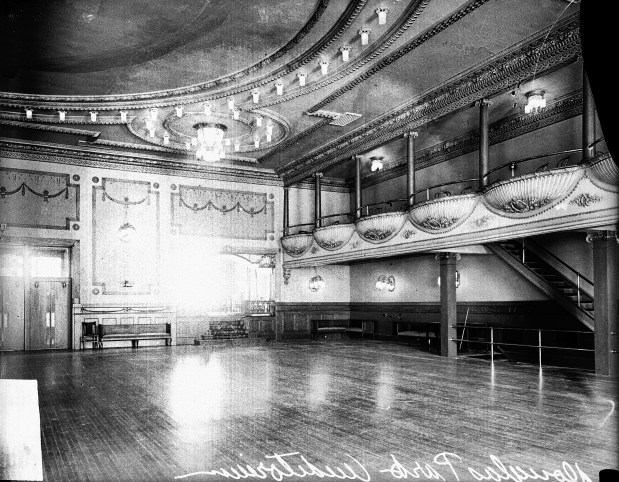
The auditorium in 1921 was the target of an unscrupulous promoter who told the press that “Mme. Pavlova” would give a benefit performance in the building. The assumption was that he meant the celebrated Russian ballerina Anna Pavlova. The Tribune told the back-story under a headline it used in those days to make clarifications on stories: “BEG YOUR PARDON:
“Louis L. Seldman who will present Mme. Anna Pavlova here at a later date writes that the dancer who will appear at the Douglas Park Auditorium is not the famous artist. The Russian consul general here sends a similar message.”
The auditorium was for many years national headquarters of the Workmen’s Circle. “A shenere un besere velt,“ was its socialist war cry. “A more equitable and beautiful world!” It operated schools that taught Yiddish to youngsters. But union activities didn’t always live up to that motto. Under the headline: “Chicken Killers Balk at Defense Fund for Elkin,” the Tribune in 1929 reported that Schechters, Judaism’s ritual slaughters, objected to being assessed a week’s salary to pay Joseph Elkin’s legal expenses. The union’s business agent, he had been indicted for conspiracy., allegedly using union funds to pay vandals to set fire to a chicken killing plant run by a woman who didn’t follow union rules.
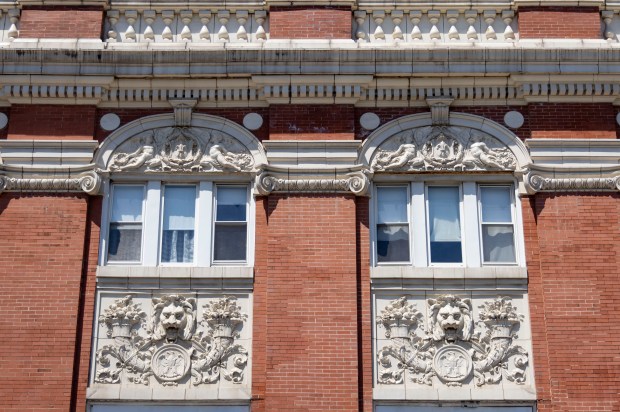
“The conservative element among the chicken killers charge that last Thursday night’s meeting at the Douglas Park Auditorium was packed with Elkin’s gang of hoodlum friends,” the Tribune reported. An enterprising reporter for the newspaper sought comment from several rabbis, none agreed to talk. “To mention my name with the Elkin charges would mean my death,” one explained.
In addition to being the site of worker struggles, the Douglas Park Auditorium was a forum for politicians courting the Jewish community’s vote or asking its forgiveness.
“The Jews of Chicago who feted Senator William Lorimer last Thursday night at a banquet in the Douglas Park Auditorium in celebration of his ‘vindication’ were hotly rebuked by Dr. T. Schanfarber in his sermon at K. A. M. Temple,” the Tribune reported in 1911.
Lorimer had allegedly paid $1,000 to secure a vote necessary to his appointment to a U.S. Senate seat from which he was ultimately expelled. Schanfarber wasn’t happy to see his fellow Jews cut the politician any slack.
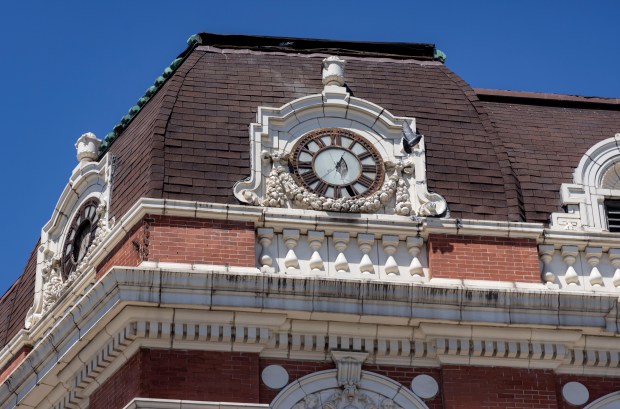
“There ought to be more religion in politics and less politics in religion,” Schanfarber said. “We deprecate the actions of Jews in this community who feasted the acquitted senator … who is held in suspicion by the most of the people in this country.”
A few years later, Adolph Germer, secretary of the Socialist Party, was arrested and charged with violating the espionage act in the Douglas Park Auditorium “as a result of a fiery speech” he was making against the draft instituted when the United States entered World War I.
“The United States has purchased 200,000 coffins and every one will be occupied by our American boys,” he said in his speech. ” “None of Rockefeller’s jewelry or oil will be buried with them.”
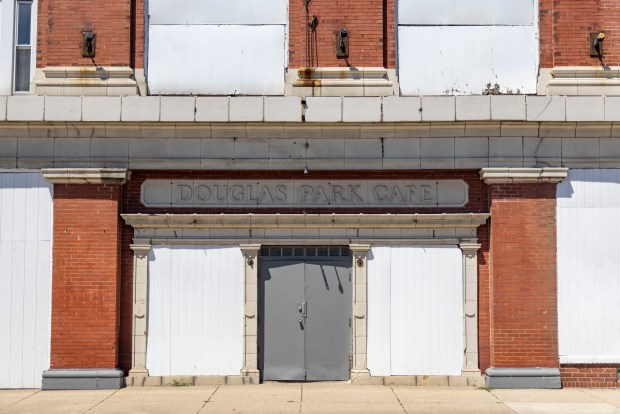
Stinging rhetoric of that sort seemed to be a staple of events at the auditorium. Four years after the contretemps over an auditorium saloon pouring drinks on Sunday, the venue hosted a debate on the Sunday dry law. The speaker on the “con” side of the argument cited the example of Chicago Mayor William “Big Bill” Thompson, who, he noted, “likes a drink.”
“And there is something he likes better than two drinks,” the speaker added. “Twenty drinks.”
“I believe beer is a good thing,” the debater concluded. “And if it is a good thing on Wednesday and Friday why isn’t it a good thing on Sunday?”
Chicago continued to embrace the free flow of liquor, even during Prohibition, but neighborhoods like the one around the auditorium went through inevitable changes. The Yiddish theater closed in 1951 and, as Jewish residents abandoned Douglas Park for greener pastures, the auditorium was sold a few years later to the Church of the Lord Jesus Christ. Its minister, Otis Hunter, said in a 2003 interview with the Chicago Reader that he still heard from people who remembered the glories of the building’s previous incarnation.
“I’ve met quite a few older Jewish people that went to many parties here,” Hunter said. “They said they’d have five or six parties going on at one time.”
Have an idea for Vintage Chicago Tribune? Share it with Ron Grossman and Marianne Mather at rgrossman@chicagotribune.com and mmather@chicagotribune.com.


